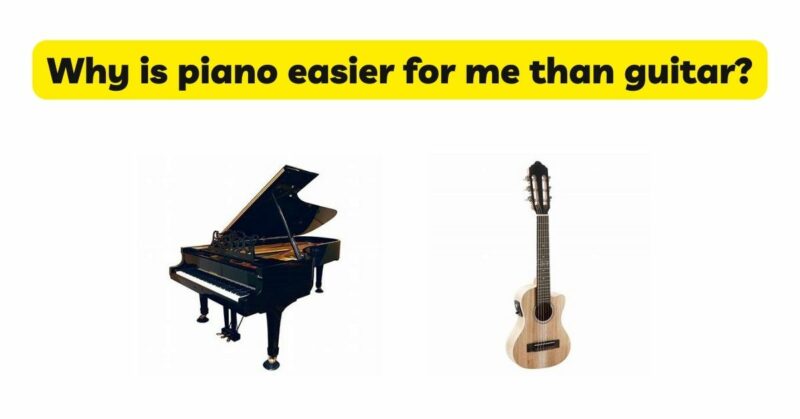In the vast realm of music, individuals often find themselves drawn to different instruments based on their personal inclinations and abilities. While both the piano and the guitar require time and dedication to master, some people may discover that they connect more effortlessly with the piano compared to the guitar. In this article, we will explore the reasons why the piano can feel easier for certain individuals, examining factors such as instrument layout, tactile feedback, music theory integration, and personal affinity.
I. Instrument Layout: The Logic in Key Patterns
- Linear Design and Visual Representation: The piano’s linear layout and visual representation of musical concepts make it an instrument that resonates with many. The black and white keys provide a clear visual reference, facilitating the understanding of scales, intervals, and chord patterns. This intuitive design enables individuals to grasp fundamental music theory concepts more easily, aiding in their overall comprehension of the instrument.
- Symmetry and Consistency: The piano’s symmetric key arrangement and consistent pattern of octaves offer a sense of predictability and structure. This uniformity can contribute to a smoother learning experience, as individuals can quickly identify patterns and transpose musical ideas across different sections of the keyboard. The consistency in finger placement and hand movements allows for efficient muscle memory development and greater ease of playability.
II. Tactile Feedback: Touching the Keys of Expression
- Weighted Keys and Responsive Touch: The piano’s weighted keys provide a tactile feedback that many individuals find conducive to their learning process. The action of pressing the keys engages the fingers and the hand muscles, contributing to a more immersive playing experience. The responsive touch of the keys allows for nuanced expression, empowering pianists to control dynamics, phrasing, and articulation effortlessly.
- Physical Sensation and Emotional Connection: For some individuals, the physical sensation of playing the piano can be deeply gratifying and emotionally fulfilling. The ability to create resonating sounds through finger pressure and release, and the sensation of the vibrations emanating from the instrument, can foster a profound connection between the pianist and the music. This tactile experience can enhance the enjoyment of playing and make the learning process feel more natural and intuitive.
III. Integration of Music Theory: A Comprehensive Approach
- Built-in Music Theory Education: Learning the piano often involves an inherent integration of music theory. Due to the keyboard’s layout and visual representation of musical concepts, pianists naturally develop an understanding of scales, chords, and harmonic progressions. This integrated approach to music theory can be advantageous, as it provides a comprehensive foundation that strengthens overall musicianship and facilitates the exploration of more complex compositions.
- Sight-Reading and Notation: The piano’s standardized notation system and two-staff sheet music format contribute to its accessibility for sight-reading. Pianists can read both the treble and bass clefs simultaneously, which allows for a holistic understanding of musical compositions. This ability to quickly interpret and perform sheet music can make the learning process feel more manageable and rewarding for individuals who enjoy visual and analytical approaches to learning music.
IV. Personal Affinity: Aligning with Preferences and Strengths
- Musical Taste and Genre Compatibility: The piano’s versatile nature allows individuals to explore a wide range of musical genres, from classical and jazz to contemporary and pop. If an individual’s musical taste aligns more closely with the piano’s repertoire, they may find it easier to connect with the instrument and engage in practice sessions. A strong personal affinity for the style of music played on the piano can foster a natural inclination and passion for learning and playing the instrument.
- Personal Strengths and Learning Style: Each individual has unique strengths and preferences when it comes to learning an instrument. Some individuals may have a natural inclination towards the piano’s tactile and visual aspects, as well as its logical layout. Moreover, individuals who excel in analytical thinking, pattern recognition, and finger dexterity may find the piano to be a more natural fit for their learning style, contributing to a perceived sense of ease.
Conclusion:
While the guitar and piano both offer fulfilling musical journeys, some individuals may find the piano to be an instrument that feels easier to connect with and learn. Factors such as the piano’s intuitive layout, tactile feedback, integration of music theory, and personal affinity can contribute to this perceived ease. The linear design, visual representation of musical concepts, and weighted keys provide a logical and immersive learning experience. The piano’s comprehensive approach to music theory and compatibility with various musical genres can foster a sense of natural inclination and ease of playability.
It is important to recognize that personal preferences, strengths, and musical aspirations play a significant role in choosing an instrument and perceiving its level of ease. Ultimately, the key to successful music learning lies in passion, commitment, and consistent practice, regardless of the instrument one chooses to pursue. Embrace the instrument that resonates with you and allows you to express yourself authentically, for it is through this connection that you will embark on a fulfilling musical journey.


